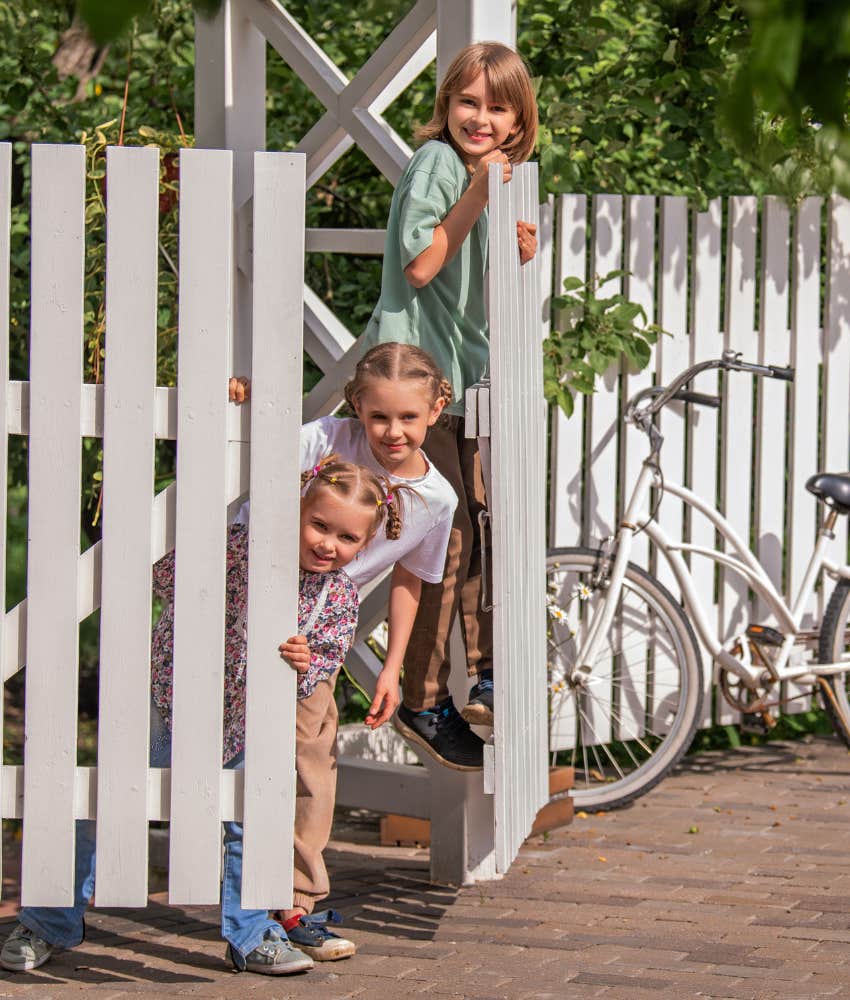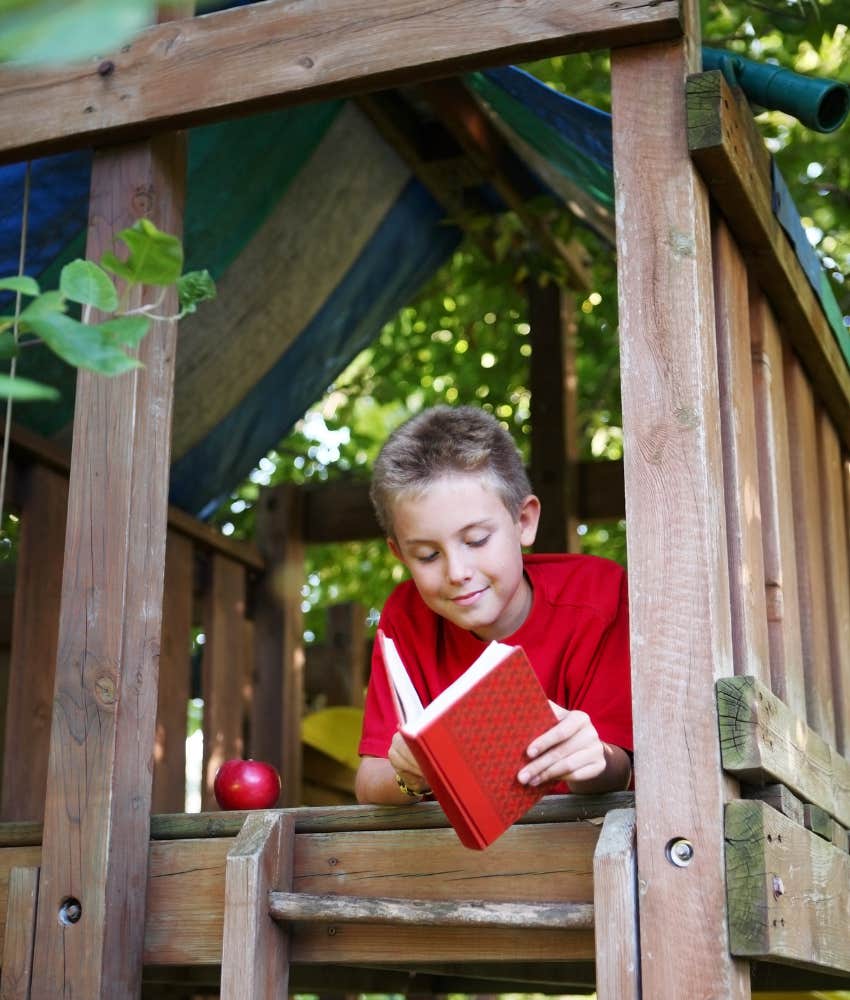7 Things That Used To Be Part Of Growing Up That Parents These Days No Longer Allow
Kids don't build treehouses anymore.
 Elzbieta Sekowska | Shutterstock
Elzbieta Sekowska | Shutterstock Kids' lives are different today, and different means a lot of the things that used to be part of growing up don't fit within our new parenting guidelines. A 2025 Harris Poll sought to discover just how different things have become. A research team led by social psychologist Jonathan Haidt asked 522 children between the ages of 8 and 12 about their childhoods. What they found is that a lot of what was considered a normal part of growing up simply does not fly with parents today.
There's no denying that childhood experiences have changed drastically in the last 50 years. Just thinking back to a world without the internet is hard to remember, even though it wasn't really all that long ago. As the world changes, parenting must change right along with it, and that means adapting to the times. Unfortunately, change, which is a wonderful way to evolve and grow, also means saying goodbye to some beloved traditions in the process.
7 things that used to be a normal part of growing up that parents today no longer allow:
1. Letting kids walk in a different aisle than their parents at a store
We all remember making a beeline for the cereal aisle at the grocery store. Your mom was likely shouting about watching where you were going or not running in a store, but she certainly wasn't concerned that you would be out of sight. You were in the same store after all.
Nowadays, being just feet away seems too far for many parents. In fact, the survey found that 45% of kids have never traversed a store without their mom or dad nearby. Remember that game where you'd hide in the clothing racks out of sheer boredom? What would parents today even say if their kids actively hid from them while out in public? It would not be good.
2. Talking with a neighbor alone
 Maria Moroz | Shutterstock
Maria Moroz | Shutterstock
There was a time when kids would visit their neighbors to talk, play, or even grab a snack. Communities were close-knit, and people knew and trusted one another. Today, that’s much less common. According to The Harris Poll, 56% of kids have never spoken to a neighbor without a parent present.
It makes sense that parents are more cautious. The world is a much different place thanks to technology, and that means the close-knit communities where everyone knew each other are a thing of the past. Most people barely even speak to, let alone "know" their neighbors well enough to have them engage with their kids.
The downside is that kids still need to learn how to engage with the world. That means, not only talking to other adults, but also learning to trust their instincts when it comes to who should be trusted and who shouldn't be. It makes sense to be cautious, but if the kiddos are simply outside talking with a neighbor doing yard work, it may be worth letting them engage. According to Better Health, it is important for parents to encourage outgoing and communicative behavior to help kids develop their communication skills.
3. Making plans with friends without help from adults
It seems that kids now rely on adults even when it comes to making plans with friends. The study found that 61% have never done this on their own.
Of course, it makes sense to ask for help when a hangout requires a ride somewhere, like going to the movies. But if the plan is something simple, like walking down the street to play soccer, kids could easily figure it out themselves.
4. Walking or biking somewhere without an adult
If you were a kid a few decades ago, chances are you got around on your bike. A friend would stop by to invite you out, you’d hop on your two-wheeler, and head off for an adventure. Sometimes that meant riding into another neighborhood to explore, and other times it was simply walking on foot. But today, the reality is that 62% of kids haven’t experienced this kind of freedom.
Go back a decade further, and there were even bike racks at school. Today, kids barely ride the bus, opting instead to get picked up and dropped off by a parent. It's not like kids are really begging for the opportunity to cruise around town, either. With busy schedules and free time taken up by technology, why would you even want to ride a bike for the sole reason of simply riding a bike?
5. Building a fort outside
 Suzanne Tucker | Shutterstock
Suzanne Tucker | Shutterstock
Many adults today remember building forts or treehouses when they were kids. What could be better than creating a clubhouse for kids only?! Free time used to be spent outside playing. Boredom bred creativity, and clubhouses and forts were built. But the Harris Poll found that 63% of kids today have never done it.
Honestly, without encouragement, why would they? Boredom has become a foreign concept. Instead, kids have instant gratification at all times thanks to screens. The problem is, they are actually missing out when it comes to free play. Free play and even risky play are integral to development, and it's quickly becoming a thing of the past.
According to the National Association for the Education of Young Children, outdoor play helps children explore science, develop social skills and collaboration, improve physical health, experience new learning contexts, sleep better, and even practice taking appropriate risks.
6. Getting paid for work
Obviously, kids shouldn’t have jobs in the traditional sense. But years ago, it was common for adults to hand neighborhood kids a few dollars for mowing lawns, shoveling snow, or babysitting. Since they can't even talk to their neighbors alone, this community involvement is completely foreign to them.
The survey unsurprisingly found that 67% haven’t had that experience, and it's unfortunate. Not only was it a good lesson in earning and the value of money, but it was also a way for kids to build self-esteem by taking pride in a job well done .
7. Using a sharp knife
Cooking and food prep are important skills for kids to learn, but parents are letting kids be kids a little longer nowadays, and that's not necessarily a bad thing. The survey found that 71% of kids have never used a sharp knife. While many parents did when they were young, they tend not to let their own children do the same. It’s seen as a precaution to prevent injuries, with the idea that kids will be allowed to handle knives once they’re older.
While safety should always come first, it’s also important to give kids the tools they will need to be independent adults, and lots of these now-banned experiences do just that. Okay, an 8-year-old might be too young to use a chef's knife, but by the time they hit 11 or 12, it's probably best to start teaching them.
Matt Machado is a writer studying journalism at the University of Central Florida. He covers relationships, psychology, celebrities, pop culture, and human interest topics.

